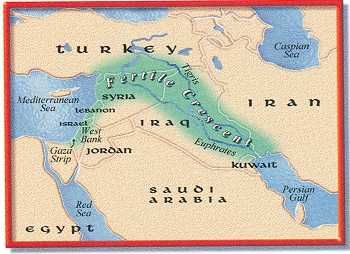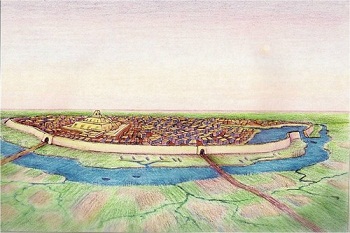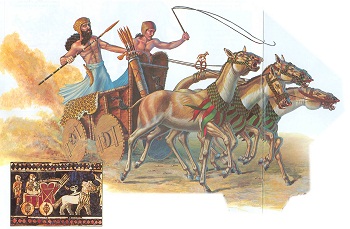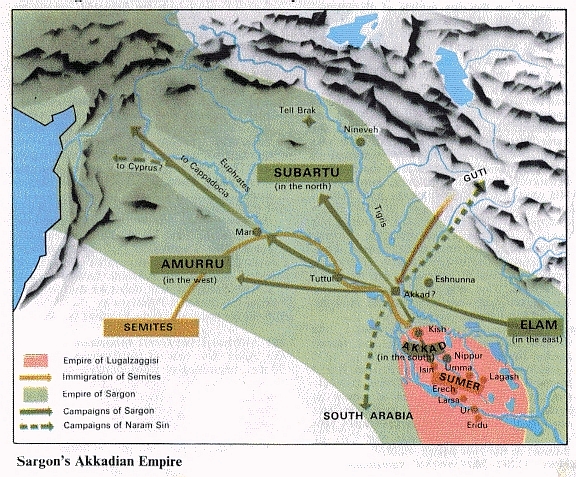
| ANCIENT MESOPOTAMIA AND EGYPT Ancient Mesopotamia and the Sumerians :
The word Mesopotamia comes from Greek words meaning "land between the rivers." The rivers are the Tigris and Euphrates. The first settlers to this region did not speak Greek, it was only thousands of years later that the Greek-speaking Alexander the Great, King of Macedonia, conquered this land and carried with him his culture.
Lower Mesopotamia is located the modern country of Iraq, while Upper Mesopotamia is in Syria and Turkey Mesopotamia is considered the cradle, or beginning, of civilization. Here large cities lined the rivers and many advances took place. Mesopotamia at first glance does not look like an ideal place for a civilization to flourish. It is hot and very dry. There is very little rainfall in Lower Mesopotamia. However, snow, melting in the mountains at the source of these two rivers, created an annual flooding. The flooding deposited silt, which is fertile, rich, soil, on the banks of the rivers every year. This is why Mesopotamia is part of the fertile crescent, an area of land in the Middle East that is rich in fertile soil and crescent-shaped.
The Sumerians were the first people to migrate to Mesopotamia, they created a great civilization. Beginning around 5,500 years ago, the Sumerians built cities along the rivers in Lower Mesopotamia, specialized, cooperated, and made many advances in technology. The wheel, plow, and writing (a system which we call cuneiform) are examples of their achievements. The farmers in Sumer created levees to hold back the floods from their fields and cut canals to channel river water to the fields. The use of levees and canals is called irrigation, another Sumerian invention.
A typical Sumerian city-state, notice the ziggurat, the tallest building in the city The Sumerians had a common language and believed in the same gods and goddesses. The belief in more than one god is called polytheism. There were seven great city-states, each with its own king and a building called a ziggurat, a large pyramid-shaped building with a temple at the top, dedicated to a Sumerian deity. Although the Sumerian city-states had much in common, they fought for control of the river water, a valuable resource. Each city-state needed an army to protect itself from its neighbors.
Mesopotamia From Nomads to Farmers
Watch the video clip below from Discovery Education, as Nissaba, a young Sumerian girl, talks about her people's accomplishments.
In 1922, English archaeologist, C. Leonard Woolley went to Southern Iraq in hopes of finding the Sumerian city-state of Ur. Woolley learned archaeology from some of the best of his day, and now he was ready to strike off on his own. Many people felt that Ur was only a myth, but Woolley, the son of a clergyman, was fascinated by the stories his father told about Ur, which, according to the Bible, was the birth place of Abraham. Abraham is a central figure of Judaism, Christianity, and Islam, three monotheistic religions.
Woolley decided to excavate near the ruins of a ziggurat and began to dig two trenches. Here, Woolley confirmed that the site was the ancient Sumerian city-state of Ur. Woolley's discovery of Ur along with the artifacts and burials there give us a glimpse of life in Sumer 4,500 years ago. Woolley discovered graves of common people, but also royal graves, including that of a Sumerian queen named Pu-Abi.
Sargon was an excellent commander, he organized his army into different units, including donkey-drawn war chariots, used to scare and trample his enemies Around 2,300 BC, the independent city-states of Sumer were conquered by a man called Sargon the Great of Akkad, who had once ruled the city-state of Kish. Sargon was an Akkadian, a Semitic group of desert nomads who eventually settled in Mesopotamia just north of Sumer. The Sumerian king, Lugal-Zaggisi, tried to form a coalition of Sumerian city-states against Sargon, but he was defeated by the Akkadian. Sargon is considered the first empire builder. Sargon made Agade the capital city of his empire.
Sargon's daughter, Enheduanna, was first world's first credited author because she signed her name to a set of poems she wrote about her gods and goddesses. Sargon's son and grandson ruled after him, but eventually the Akkadian Empire fell, and was replaced by the Old Babylonian Empire. We will learn more about the Babylonians in the next chapter.
The Akkadian Empire stretched across all of Mesopotamia. You can see the military campaigns of both Sargon, and his grandson, Naram Sin. |



